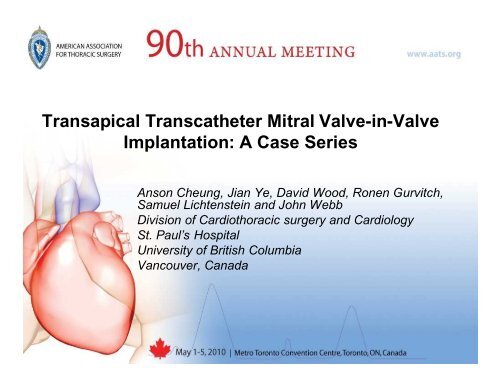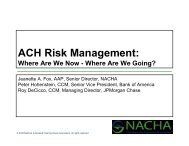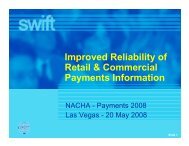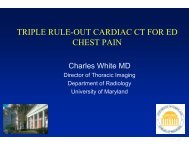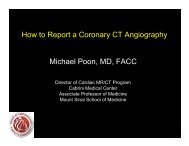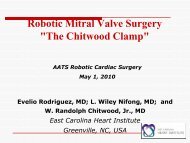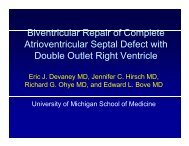Transapical Transcatheter Mitral Valve-in-Valve Implantation: A ...
Transapical Transcatheter Mitral Valve-in-Valve Implantation: A ...
Transapical Transcatheter Mitral Valve-in-Valve Implantation: A ...
You also want an ePaper? Increase the reach of your titles
YUMPU automatically turns print PDFs into web optimized ePapers that Google loves.
<strong>Transapical</strong> <strong>Transcatheter</strong> <strong>Mitral</strong> <strong>Valve</strong><strong>in</strong><strong>Valve</strong><strong>Implantation</strong>: A Case SeriesAnson Cheung, Jian Ye, David Wood, Ronen Gurvitch,Samuel Lichtenste<strong>in</strong> and John WebbDivision of Cardiothoracic surgery and CardiologySt. Paul’s HospitalUniversity of British ColumbiaVancouver, Canada
Presenter DisclosureAnson Cheung, Jian Ye and John WebbThe follow<strong>in</strong>g relationships exist related to thispresentation:Edwards Lifesciences, Received, Role (Consultant,Speakers Bureau)
Structural <strong>Valve</strong> Deterioration• Increas<strong>in</strong>g use of bioprosthesis– In younger patients– Expected <strong>in</strong>crease <strong>in</strong> redo MVR for SVD• High mortality and morbidity of reoperative MV surgery <strong>in</strong>elderly population• Technical difficulties (<strong>in</strong>jury to grafts and other cardiacstructures and myocardial protection)
<strong>Transcatheter</strong> <strong>Valve</strong><strong>in</strong><strong>Valve</strong> ConceptEdwards SapienPericardial <strong>Valve</strong>CE Perimount
Objectives• Feasibility and Safety of transapical transcathetermitral valve<strong>in</strong>valve implantation (TVIVi) <strong>in</strong>patients that were deemed too high risk forconventional redo MVR• To study the cl<strong>in</strong>ical and hemodynamic outcomes
Case IEcho MVA 0.5 cm 2 MG 17mmHg Severe MR EF 65% PAP 90mmHg
<strong>Transapical</strong> <strong>Transcatheter</strong> <strong>Mitral</strong> <strong>Valve</strong><strong>in</strong><strong>Valve</strong> <strong>Implantation</strong> <strong>in</strong> a Human(Case performed <strong>in</strong> 2007)A Cheung, J Webb, D. Wong, J Ye Ann Thorc Surg 2009;e18e20
Echo Well seated MG 5mmHg no paravalvular leak
<strong>Transapical</strong> AV implantation and <strong>Mitral</strong> <strong>Valve</strong><strong>in</strong><strong>Valve</strong>for AS and MV SVD
Results• From July, 2007 to April, 2010• 8 patients underwent transapical TVIVi at St.Paul’s Hospital, Vancouver, Canada• All turned down by >2 surgeons for conventionalredo MVR
Patient Age STS Risk Score(%)NYHAClass1 80 20.6 32 78 16.4 33 80 11.9 44 84 19.0 35 73 18.5 46 77 7.3 37 84 19.1 48 89 28.2 4Mean 81± 5 17.6± 6.2ComorbiditiesCABG/MVRCAD, Pulm HTN, HTN, COPD, A. fib, CRICABG/MVRSevere AS and MV SVD, Isch CM, HTN,A.fib, CRI, HemolysisMVRHTN, COPD, Alcoholic cirrhosisMVRPulm HTN, A.fibCABG/MVR X 2CAD, HTN, A.fib, CRICABG/MVRCAD, A. fib, PVDAVR/MVR, Redo AVR/TV repairA.fib, CRIMVRHTN, A.fib, CRI, COPD, Pulm HTN
Patient <strong>Valve</strong> Type Failure Mode <strong>Valve</strong> Age(Yrs)12345678CE Perimount25mmCE S.A.V27mmCE S.A.V27mmMedtronicMosaic 25mmCE S.A.V27mmMedtronicIntact 27mmMedtronicMosaic 23mmCE Porc<strong>in</strong>e29 mmStenosis 7Regurgitation 11RegurgitationStenosisRegurgitationStenosis +RegurgitationRegurgitationRegurgitation13924111011<strong>Valve</strong> ImplantedCribierEdwards26mmEdwards SAPIEN26mmEdwards SAPIEN26mmEdwards SAPIEN26mmEdwards SAPIEN23mmEdwards SAPIEN23mmEdwards SAPIEN23mmEdwards SAPIEN26mm
• All had successful implantsResults• No hemodynamic <strong>in</strong>stability requir<strong>in</strong>g CPB support• No valve embolization or malposition<strong>in</strong>g• No apical hemorrhage• No reoperation for bleed<strong>in</strong>g or tamponade
Hemodynamic ResultsPatientMean Gradient(mmHg)Mean Gradient Post (mmHg)Regurgitant GradeRegurgitant GradePost1 17 6 1+ 02 8 9 4+ 03 10 9 4+ 04 18 9 1+ 1+5 11 8 4+ 1+6 20 7 4+ 07 9 6 4+ 18 7 3 4+ 0Mean 17.5 (9,17) 7.5 (6, 9)
• No 30day mortalityResults• One patient died 45 days postop, suffered periop CVA,pneumonia and sepsis• All other patients are alive and <strong>in</strong> NYHA I/II• Median Followup = 234 days (153, 311)• Longest Followup = 556 days
Summary• <strong>Transapical</strong> approach offers a direct and precise accessto the MV prosthesis• <strong>Transapical</strong> mitral valve<strong>in</strong>valve implantation istechnically feasible with predictable results
Summary• Provided good early cl<strong>in</strong>ical and hemodynamic outcomes– effective <strong>in</strong> treat<strong>in</strong>g prosthetic SVD (Insufficiency andstenosis)– stable valve<strong>in</strong>valve configuration– trace or no perivalvular leak– acceptable transvalvular gradient• <strong>Valve</strong><strong>in</strong>valve becomes more cl<strong>in</strong>ical important– more biological prosthesis implanted– advanced age at time of reoperation


